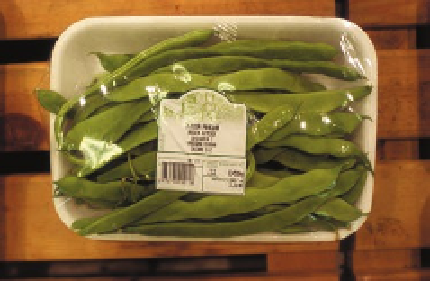Agriculture Reference
In-Depth Information
production of vegetables are receiving
increasing attention from consumers.
Stabilization in the demand for fresh
vegetables in Europe is due, mainly, to: (i)
the abundance and variety in the offer of
food in general and vegetables in particu-
lar (Photo 16.4); (ii) the reduction in the
population increase rates; and (iii) a
decrease in the food expense within the
consumer's budget (Wijnands, 2003).
Despite this, for some vegetables such as
tomato and pepper, the consumption
increases are due to: (i) less time being
available to cook (as the housewife works
out of the family home so she uses food
such as these fresh vegetables that are easy
to prepare); (ii) the good image of food
safety of fresh vegetables in view of
increasing consumer concerns about food
safety; (iii) the availability of fresh vegeta-
bles in the markets throughout the whole
year; (iv) the increasing habit of eating
smaller quantities but several times a day
(to adapt to the working hours); and (v) a
demand for more varied and attractive
products with diversity in presentation
and flavours (Wijnands, 2003).
Although fruits and vegetables represent
less than 10% of the sales of big distribution
companies, they are a key factor in the fre-
quency of visits to the supermarket from the
consumers, which justifies their interest
from the large distribution companies
(García-Azcarate and Mastrostefano, 2002).
The diversification in the offer of fresh
vegetables has been more based on new
presentations of already known products,
with several colours, shapes or sizes (tomato
types, coloured peppers, mini-vegetables)
or in the use of quality distinctions (such as
integrated production or organic produc-
tion), than in the introduction of new horti-
cultural species.
The inclusion of the marketing costs in
the final price of the product oscillates
depending on the destination market
(national or foreign) due to differences in the
transportation costs. In Spain, the produc-
tion costs of export vegetables involves
35-50% of the wholesaler's market prices
(Caballero and Miguel, 2002), whereas, in
The Netherlands, growers receive 25-30% of
Photo 16.3.
Packaging in small units is
increasingly used in fresh fruits and vegetables.
which will be key factors in maintaining the
competitiveness in the increasingly global
European markets.
Traditionally the export markets
have been a destination for a small part
of the Spanish vegetable production, due
to the perishable nature of the product
and the distance. However, the demand for
fresh vegetables has expanded throughout
the whole year which, together with the
liberalization of the European markets, has
increased the importance of exports.
Except for some specialty products
(cucumber, pepper and melon, among oth-
ers), it is usual for growers to produce com-
mercial types that are accepted in both
national and foreign markets so that there
are two destinations for production.
The European vegetable markets are
characterized by: (i) a saturation of the offer;
(ii) an increase in the quality control require-
ments and of new values (codification, trace-
ability); (iii) an adjustment of the growing
seasons (requirement for year-round sup-
ply); (iv) a certain blocking of the demand;
and (v) the globalization and liberalization
of the markets (Planells and Mir, 2000).
In increasingly competitive markets,
the differentiation of the products is one of
the classical measures used by economic
agents. The differentiation in fresh vegeta-
bles is based on covering the consumer's
expectations regarding organoleptic quality
and food safety, by means of the good policy
of quality and traceability (see Chapter 15).
Other concerns regarding environ-
mental, ethical and social aspects of the

